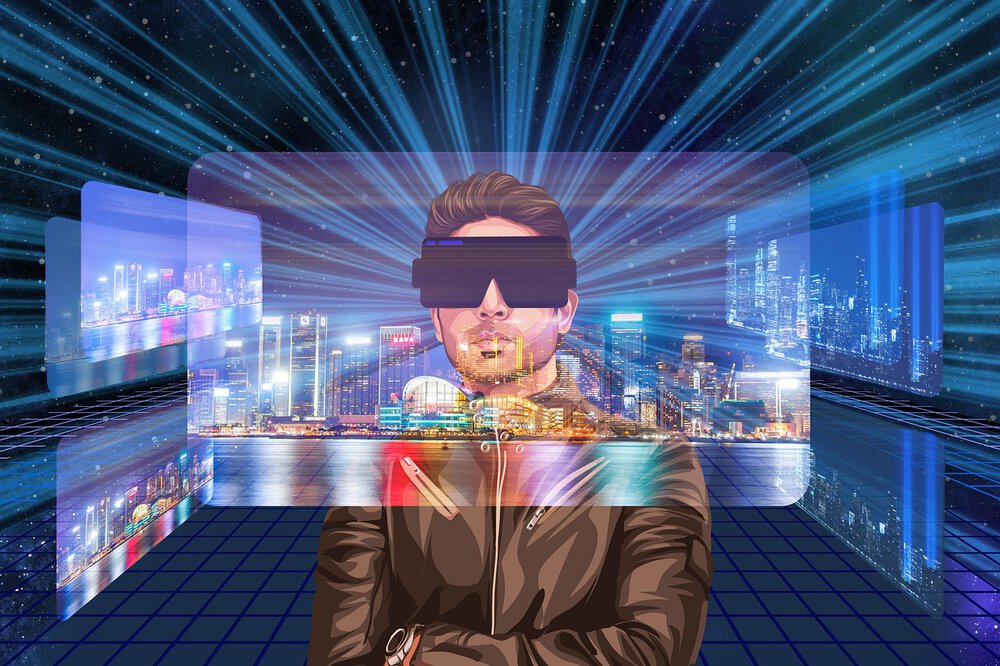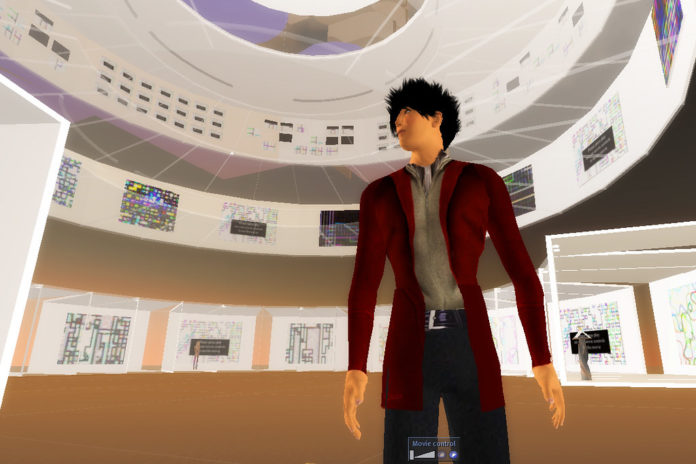The digital age has brought the promise of endless possibilities, and none have captured the imagination quite like the concept of the “metaverse.” At its core, the metaverse – a term by Neal Stephenson in his 1992 opus, “Snow Crash” – embodies a digital utopia, a collective virtual space melding augmented physical reality and a persistent virtual realm. Its vision: a borderless universe where avatars live, work, and play. From humble roots in speculative fiction, the concept morphed into a dazzling idea that seduced tech moguls, game developers, luxury brands, and the general populace. Yet, like many shining promises, the metaverse’s glow is showing signs of dimming, prompting some to ask if this was but a digital mirage, a trend bubble close to bursting.

The Meteoric Rise of the Metaverse
The metaverse’s conceptual lineage can be traced back to early digital sandboxes. Platforms like Second Life offered a glimpse of virtual self-expression, letting users curate identities and form communities. World of Warcraft spun tales of adventures in digital realms, showcasing the potential of expansive online worlds.
The leap from these pioneering spaces to a comprehensive metaverse came with the rapid evolution of AR and VR technologies. Suddenly, the abstract became tangible. Oculus Rift headsets transported users to otherworldly domains. AR games like Pokémon Go bridged virtual creatures with real-world locales.
“We believe the metaverse will be the successor to the mobile internet, and creating this product ecosystem is the next chapter for our company”
Mark Zuckerberg, CEO of META in October 2021
Enter the tech juggernauts. Facebook’s bold pivot to “Meta” wasn’t a mere name change; it heralded a mission shift to becoming a metaverse frontrunner. Platforms like Roblox and Fortnite weren’t far behind, with expansive environments transcending traditional gaming.
The luxury sector, ever keen on exclusivity and innovation, eyed the metaverse’s potential with interest. Gucci, for instance, didn’t just release virtual sneakers; they created entire digital fashion shows. Louis Vuitton ventured beyond physical artistry, embracing NFTs and digital art spaces. Burberry joined the video game “Blankos Block Party,” weaving their designs into the very fabric of virtual gameplay. It wasn’t just about selling products but crafting immersive brand experiences.

The Metaverse and Luxury: The Louis Vuitton study case.
In the luxury domain, few names carry the weight and legacy of Louis Vuitton. Founded in 1854, this Parisian luxury house has consistently exemplified the confluence of craft, art, and innovation. When the winds of the metaverse began to sweep the global stage, Louis Vuitton, true to its pioneering spirit, didn’t stand by as a mere spectator. Instead, it sought to craft its unique narrative within this digital realm.

Project Overview
One of Louis Vuitton’s most notable forays into the metaverse was its collaboration with the virtual world of “League of Legends” (LoL), one of the most popular e-sports games globally. In 2019, Louis Vuitton designed a bespoke trunk for the LoL World Championship trophy, intertwining the brand’s storied legacy with the futuristic vibe of e-sports. However, their engagement went a step further. Nicolas Ghesquière, Louis Vuitton’s Artistic Director, designed exclusive in-game skins and a capsule collection inspired by the game, symbolically merging the universes of luxury fashion and online gaming.

Objectives
Louis Vuitton’s metaverse manoeuvre served several strategic aims:
- ”Relevance to Younger Audiences: By connecting with“League of Legends,” Louis Vuitton tapped into a player base that boasted millions of millennials and Gen Z, a demographic luxury brands are keen to engage.“Relevance to Younger Audiences: By connecting with “League of Legends,” Louis Vuitton tapped into a player base that boasted millions of millennials and Gen Z, a demographic luxury brands are keen to engage.
- Brand Innovation: The initiative showcased Louis Vuitton’s willingness to innovate, positioning the brand at the forefront of luxury digital exploration.
- Exclusivity and Experience: By introducing unique in-game items and a limited-edition capsule collection, Louis Vuitton continued its legacy of creating exclusive, sought-after products, even in a virtual space.
Results and Reception:
- Broadened Reach: The collaboration garnered attention from the fashion and gaming communities, ensuring Louis Vuitton was a topic of conversation in realms where it traditionally might not have been a focus.
- Cultural Impact: The move was celebrated as a successful blending of high fashion and e-sports, two sectors that hadn’t previously interacted on such a scale. Fashion critics and gaming enthusiasts discussed and dissected the collaboration, leading to an expansive cultural dialogue.
- Commercial Success: While exact figures remain proprietary, the buzz generated by this collaboration likely translated into heightened interest and sales for the brand. The limited-edition capsule collection, both virtual and physical, was highly sought after, underscoring the commercial potential of such ventures.
Learnings
Louis Vuitton’s foray into the metaverse via “League of Legends” is a testament to its commitment to evolve while retaining its essence. By recognizing the potential of the metaverse early on and harnessing its power innovatively, Louis Vuitton reaffirmed its status as a luxury trailblazer. While the metaverse continues to be a polarizing realm, with its fair share of supporters and sceptics, there’s no denying the impact of Louis Vuitton’s bold move. It serves as a benchmark for luxury brands seeking to navigate the turbulent yet tantalizing waters of the digital realm.
Metaversal Misadventures and Critiques
Yet, this ambitious climb towards a digital zenith wasn’t without stumbles. Central to the metaverse’s allure was its democratized vision: a space for all. The reality proved different. Instead of a decentralized paradise, large corporations began staking vast claims, leading to a Silicon Valley-esque land grab.
Examples of missteps abound. In their eagerness to monetize the virtual, some brands faced accusations of insensitivity. Digital fashion pieces, priced similarly to their physical counterparts, seemed ludicrous to many. Was it reasonable to charge hundreds for pixels and code? And when high-end brands sold virtual real estate at prices rivalling Manhattan penthouses, it underscored a disconnect.

Then came instances of “metaverse malaise.” Virtual concerts, though revolutionary, sometimes felt cold and impersonal. Digital art galleries, devoid of ambience, occasionally lacked the emotional resonance of their brick-and-mortar counterparts.
Eminent voices have also risen in caution. Jaron Lanier, a VR pioneer, has persistently raised ethical concerns. He worries that an over-reliance on virtual realms might lead to societal fragmentation and dehumanization. Dr Sherry Turkle, esteemed for her work on the psychology of tech, has similarly raised red flags. In her view, digital interactions, if over-prioritized, can erode the quality of human relationships.
“We are being led to a future that we did not choose, and it’s being constructed in stealth”
Shoshana Zuboff, in The Age of Surveillance Capitalism
The Mirage of Metaversal Luxury: Balenciaga’s Virtual Venture Gone Wrong
In the quest to blend luxury with digital frontiers, success stories abound. Yet, for every triumph, there’s a cautionary tale. One such tale emerges from the house of Balenciaga, a luxury brand revered for its avant-garde approach to fashion. Balenciaga answered the call when the metaverse beckoned, but the results were not as anticipated.
Project Overview
Balenciaga, in its ambition to carve a niche in the metaverse, launched a virtual “Balenciaga City” within a popular virtual reality (VR) platform. Drawing inspiration from their iconic city bag, they envisioned a sprawling, digital metropolis. Users could navigate the streets, interact with digital storefronts, purchase virtual fashion items, and even attend virtual fashion shows. It seemed like a dream, a realm where fashion enthusiasts could immerse themselves in Balenciaga’s universe without stepping out of their homes.
Objectives
Balenciaga’s virtual venture was anchored in several goals:
- Digital Immersion: The brand aimed to offer fans an unparalleled digital experience, encapsulating the essence of Balenciaga in a VR setting.
- Engaging the Tech-savvy: Recognizing the growing trend of VR and AR among younger consumers, the brand sought to engage this demographic, fusing tech with luxury.
- Sales and Exclusivity: With unique virtual items and experiences, Balenciaga aimed to drive digital sales, catering to a clientele seeking exclusivity in both physical and virtual realms.
Results and Reception
- Technical Glitches: The launch, unfortunately, was marred by technical issues. Users reported frequent crashes, poor navigation, and latency problems, deterring many from returning after their initial visit.
- Perceived Gimmickry: Critics and users felt the city, while visually appealing, lacked depth and genuine engagement. It came off as a superficial replication of a luxury experience rather than an authentic digital extension of the brand.
- Economic Setback: The virtual items, though exclusive, faced backlash over their pricing strategy. Many questioned the rationale behind purchasing digital wearables and accessories at prices rivalling physical goods. The expected sales boom was more of a whimper, with many items remaining unpurchased.
- Dilution of Brand Image: For a brand that prided itself on exclusivity and avant-garde designs, the venture into the metaverse, given its lacklustre execution, somewhat diluted its image. Fans began questioning if the brand was losing touch with its core ethos in a bid to chase digital trends.

Learnings
Balenciaga’s journey into the metaverse is a stark reminder that successfully integrating luxury into digital realms requires more than just a vision. Execution, user experience, and genuine value are paramount. The brand’s misstep underscores luxury houses’ challenges in the digital age, balancing innovation with authenticity.
However, it’s also a testament to the resilience of luxury brands. While this venture didn’t pan out as expected, Balenciaga’s commitment to innovation remains unshaken. Though a setback, the episode offers invaluable lessons for the brand and the wider luxury industry. In the realm of the metaverse, the journey, with its highs and lows, has only just begun.
To Conclude,
We must ponder the metaverse’s true worth as we navigate this digital crossroads. Undoubtedly, its potential is vast. Imagine a world with global virtual classrooms, boundary-less concerts, and digital travel that feels as real as the tangible. The metaverse could revolutionize sectors from education to entertainment.
However, cautionary tales remind us that humanity must be at the heart of innovation. What use is a perfectly rendered digital sunset if it blinds us to the beauty of the real one? And while a virtual hug might offer solace, it can’t replace the warmth of a human embrace.
As the metaverse’s trajectory unfolds, its destiny remains uncertain. Perhaps it will find equilibrium, blending the best of both worlds. Or it might serve as a cautionary tale of tech ambition outpacing human need.
In our quest for digital immersion, let’s remember to occasionally resurface, take a breath, and savour the tangible. After all, why settle for virtual reality when you can have a vivid one? And who knows, maybe the best “server” for life is still good ol’ Mother Earth!

José Amorim
Information sourced by the author for luxuryactivist.com. All content is copyrighted with no reproduction rights available. Images are for illustration purposes only.
